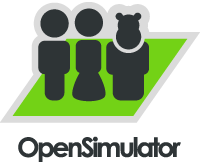
Second Life is a multiplayer virtual world that allows people to create an avatar for themselves and then interact with other users and user-created content within a multi-user online environment. Developed for personal computers and owned by the San Francisco-based firm Linden Lab, it launched on June 23, 2003 and saw rapid growth for some years; in 2013 it had approximately one million regular users. Growth eventually stabilized, and by the end of 2017, the active user count had fallen to "between 800,000 and 900,000". In many ways, Second Life is similar to massively multiplayer online role-playing video games; nevertheless, Linden Lab is emphatic that their creation is not a game: "There is no manufactured conflict, no set objective."
A virtual environment is a networked application that allows a user to interact with both the computing environment and the work of other users. Email, chat, and web-based document sharing applications are all examples of virtual environments. Simply put, it is a networked common operating space. Once the fidelity of the virtual environment is such that it "creates a psychological state in which the individual perceives himself or herself as existing within the virtual environment" then the virtual environment (VE) has progressed into the realm of immersive virtual environments (IVEs).

In computing, an avatar is a graphical representation of a user, the user's character, or persona. Avatars can be two-dimensional icons in Internet forums and other online communities, where they are also known as profile pictures, userpics, or formerly picons. Alternatively, an avatar can take the form of a three-dimensional model, as used in online worlds and video games, or an imaginary character with no graphical appearance, as in text-based games or worlds such as MUDs.
A warp, also known as a portal or teleporter, is an element in video game design that allows a player character instant travel between two locations or levels. A specific area that allows such travel is referred to as a warp zone. A warp zone might be a secret passage, accessible only to players capable of finding it, but they are also commonly used as a primary mean of travel in certain games. Warps might be deliberately installed within puzzles, be used to avoid danger in sections of a game that have been previously accomplished, be something a player can abuse for cheating, or be used as a punishment to a player straying from the "correct" path.
The Croquet Project is a software project that was intended to promote the continued development of the Croquet open-source software development kit to create and deliver collaborative multi-user online applications. Croquet is implemented in Squeak Smalltalk.
Object hyperlinking is a term that refers to extending the Internet to objects and locations in the real world. Object hyperlinking aims to extend the Internet to the physical world by attaching tags with URLs to tangible objects or locations. These object tags can then be read by a wireless mobile device and information about objects and locations retrieved and displayed.

PlayStation Home was a virtual 3D social gaming platform developed by Sony Computer Entertainment's London Studio for the PlayStation 3 (PS3) on the PlayStation Network (PSN). It was accessible from the PS3's XrossMediaBar (XMB). Membership was free but required a PSN account. Upon installation, users could choose how much hard disk space they wished to reserve for Home. Development of the service began in early 2005 and it launched as an open beta on 11 December 2008. Home remained as a perpetual beta until its closure on 31 March 2015.

OpenSimulator is an open-source server platform originally launched in 2007 for hosting virtual worlds and metaverse environments. It is largely compatible with the virtual world Second Life but full compatibility is not a design goal.
Open Wonderland is an open-source toolkit written in Java for creating collaborative 3D virtual worlds. Within those worlds, users can communicate with high-fidelity, immersive audio, share live desktop applications and documents in addition to conducting real business. Open Wonderland is completely extensible; developers and graphic artists can extend its functionality to create entirely new worlds, including but not limited to adding new features to existing worlds.

Open Cobalt is a free and open-source software platform for constructing, accessing, and sharing virtual worlds both on local area networks or across the Internet, with no need for centralized servers.

Twinity is a 3D online virtual world. Initially developed by Metaversum GmbH, it is currently held by ExitReality. The game offers its population, called Twinizens, to navigate around virtual (historical) versions of real-world cities, also called a mirror world or a Metaverse. A public beta began in September 2008, with the release of the first virtual city, Berlin, which later was followed by Singapore, London, Miami and New York. Twinity is built on BigWorld Technology and its economy is based on a free-to-play model.
Virtual worlds are playing an increasingly important role in education, especially in language learning. By March 2007 it was estimated that over 200 universities or academic institutions were involved in Second Life. Joe Miller, Linden Lab Vice President of Platform and Technology Development, claimed in 2009 that "Language learning is the most common education-based activity in Second Life". Many mainstream language institutes and private language schools are now using 3D virtual environments to support language learning.

Teleportation is the theoretical transfer of matter or energy from one point to another without traversing the physical space between them. It is a common subject in science fiction and fantasy literature, film, video games, and television. In some situations, teleporting is presented as time traveling across space.
The virtual world framework (VWF) is a means to connect robust 3D, immersive, entities with other entities, virtual worlds, content and users via web browsers. It provides the ability for client-server programs to be delivered in a lightweight manner via web browsers, and provides synchronization for multiple users to interact with common objects and environments. For example, using VWF, a developer can take video lesson plans, component objects and avatars and successfully insert them into an existing virtual or created landscape, interacting with the native objects and users via a VWF interface.
Military Open Simulator Enterprise Strategy (MOSES) is a U.S. Army project evaluating the ability of OpenSimulator to provide independent and secured access to a virtual world.
Portal chess is a chess variant which uses at least two fairy pieces called portals. These pieces can be easily added by using poker chips, coins or other suitably sized objects. The game seeks to incorporate portals to allow pieces to teleport around the board. Apart from the portals and their ruleset, the game often plays like ordinary chess, including the en passant capture, castling, and promotion.

GameFace Labs is an American technology company that develops hardware and software for the consumer virtual reality market, and was founded in 2013 by Edward Mason. The company's headquarters are in San Francisco, with international offices in London, United Kingdom.

VRChat is an online virtual world platform created by Graham Gaylor and Jesse Joudrey and operated by VRChat, Inc. The platform allows users to interact with others with user-created 3D avatars and worlds. VRChat is designed primarily for use with virtual reality headsets, being available for Microsoft Windows PCs and as an app for Android-based headsets such as the Meta Quest, Pico 4, and HTC Vive XR Elite. VRChat is also playable without a virtual reality device in a "desktop" mode designed for a mouse and keyboard, gamepad, or mobile app for touchscreen devices.

Rec Room is a 2016 virtual reality massively multiplayer online game with an integrated game creation system. It is released on Windows, Xbox One, Xbox Series X/S, PlayStation 4, PlayStation 5, PS VR, Meta Quest 2, Oculus Quest, Meta Quest 3, Meta Quest Pro, Oculus Rift, Pico 4, iOS, Android and Nintendo Switch.

Meta Horizon Worlds is an online virtual reality game with an integrated game creation system developed and published by Meta Platforms. On this multi-player virtual platform, players move and interact with each other in various worlds that host events, games, and social activities. They can also build and publish worlds similar to Rec Room. Horizon Worlds works on Oculus Rift S, Meta Quest 2, Meta Quest Pro and Meta Quest 3 headsets.











